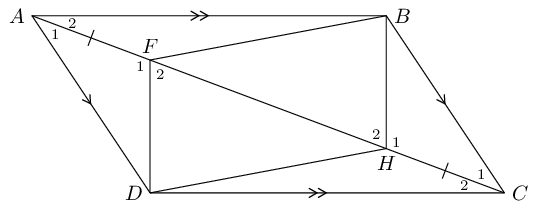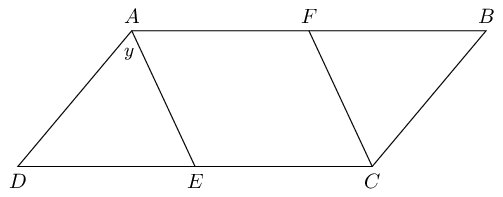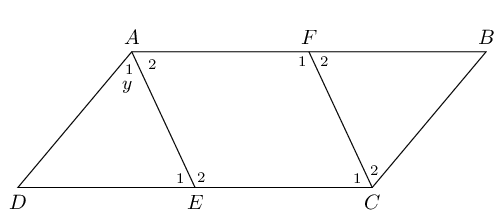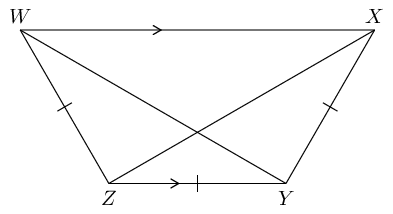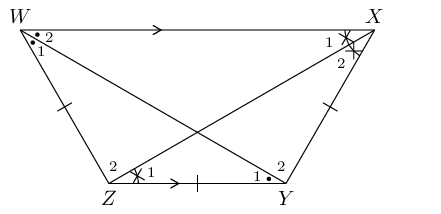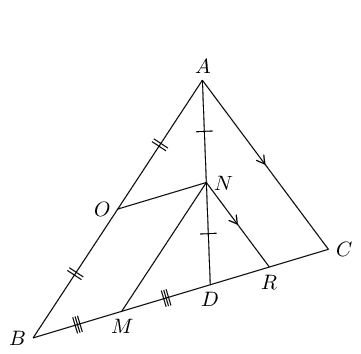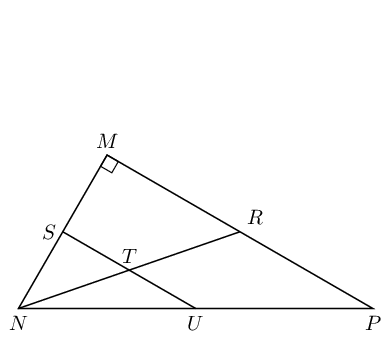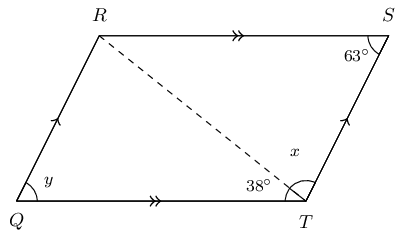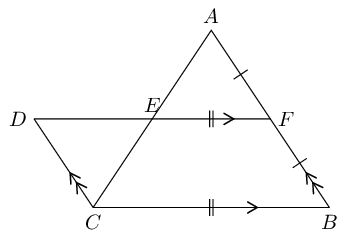\(ABCD\) is a rhombus with \(AM = MO\) and \(AN = NO\). Prove \(ANOM\) is also a rhombus.
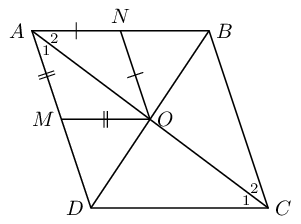
In \(\triangle AMO\) and \(\triangle ANO\)
\(\hat{A}_1 = \hat{A}_2\) (given rhombus \(ABCD\), diagonal \(AC\) bisects \(\hat{A}\))
\(\therefore \hat{A_1} = A\hat{O}M\) (\(\angle\)s opp equal sides)
similarly \(\hat{A}_2 = A\hat{O}N\)
\(\therefore \hat{A}_2 = A\hat{O}M\) and \(\hat{A}_1 = A\hat{O}N\)
but these are alternate interior \(\angle\)s
\(\therefore AN \parallel MO\) and \(AM \parallel NO\)
\(\therefore ANOM\) is a parallelogram
\(\therefore AM = NO\) (opp sides of \(\parallel\)m)
\(\therefore AM = MO = ON = NO\)
\(\therefore ANOM\) is a rhombus (all sides equal and two pairs of sides parallel)
\(\triangle AFD \equiv \triangle CHB\)
\begin{align*}
\hat{A}_1 & = \hat{C}_1 \qquad \text{(alt }\angle \text{s; }AD \parallel BC \text{)}\\
AD & = BC \qquad \text{(opp sides } \parallel \text{m)}\\
AF& = HC \qquad \text{(given)}\\
\therefore \triangle AFD &\equiv \triangle CHB \qquad \text{(SAS)}
\end{align*}
\begin{align*}
\hat{F}_1 &= \hat{H}_1 \qquad (\triangle AFD \equiv \triangle CHB)\\
\therefore \hat{F}_1 +\hat{F}_2 &= 180° \qquad \text{(}\angle\text{s on str line)}\\
\text{and } \hat{H}_1 +\hat{H}_2 &= 180° \qquad \text{(}\angle \text{s on str line)}\\
\therefore \hat{F}_1 &= 180° - \hat{F}_2 \\
\text{and } \hat{H}_1 &= 180° - \hat{H}_2 \\
\therefore 180° - \hat{F}_2 & = 180° - \hat{H}_2 \\
\therefore \hat{F}_2 & = \hat{H}_2 \\
\therefore DF &\parallel HB \qquad \text{(corresp } \angle \text{s equal)}
\end{align*}
\(DFBH\) is a parallelogram
\begin{align*}
FD & = HB \qquad (\triangle AFD \equiv \triangle CHB)\\
\text{and }DF &\parallel HB \qquad \text{ (proved above)}\\
\therefore DFBH & \text{ is a parallelogram (one pair opp sides equal and parallel)}
\end{align*}
Prove \(U\) is the mid-point of \(NP\).
\begin{align*}
NS&=SM \text{ (given)}\\
NT&=TR \text{ (given)}\\
\therefore ST &\parallel MR \text{ (Midpt Theorem)} \\
\therefore U & \text{ is the mid-point of } NP \text{ (converse of Midpt Theorem)}
\end{align*}
If \(ST = \text{4}\text{ cm}\) and the area of \(\triangle SNT\) is \(\text{6}\) \(\text{cm$^{2}$}\),
calculate the area of \(\triangle MNR\).
\begin{align*}
N\hat{S}T & = 90° \text{ (corresp }\angle \text{s; } ST \parallel MR)\\
\therefore \text{ area }\triangle SNT &=\frac{1}{2} ST \times SN \\
6 &= \frac{1}{2}(4)SN\\
\therefore SN &= \text{3}\text{ cm}\\
\therefore MN &= \text{6}\text{ cm} \\
MR &= 2ST = \text{8}\text{ cm}\\
\text{area }\triangle MNR &= \frac{1}{2} MR \times MN\\
&=\frac{1}{2} (8)(6)\\
&= \text{24}\text{ cm$^{2}$}
\end{align*}
Prove that the area of \(\triangle MNR\) will always be four times the area of \(\triangle SNT\), let
\(ST = x \text{ units}\) and \(SN = y \text{ units}\).
\begin{align*}
\text{Let }ST \text{ be } & x \text{ units}\\
\therefore MR \text{ will be } & 2x\\
\text{Let }SN \text{ be } & y \text{ units}\\
\therefore MN \text{ will be } & 2y\\
\text{area }\triangle SNT & = \frac{1}{2}xy \\
\text{area }\triangle MNR & = \frac{1}{2} (2x)(2y) \\
& = 2xy\\
\therefore \text{ area } \triangle MNR &= 4\left(\frac{1}{2}xy\right) \\
& = 4(\text{area }\triangle SNT)
\end{align*}
Study the quadrilateral \(QRST\) with opposite angles \(\hat{Q} = \hat{S} = 117^{\circ}\) and angles
\(\hat{R} = \hat{T} = 63^{\circ}\) carefully. Fill in the correct reasons or steps to prove that the
quadrilateral \(QRST\) is a parallelogram.
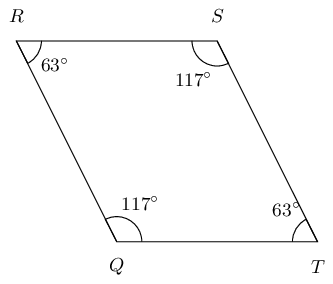
\[\begin{array}{|l |l|}
\hline
\text{Steps} & \text{Reasons} \\
\hline
R\hat{Q}T = R\hat{S}T & \text{given both } \angle \text{s } = 117^\circ \\
Q\hat{R}S = Q\hat{T}S & \text{given both } \angle \text{s } = 63^\circ \\
\hat{Q} + \hat{R} + \hat{S} + \hat{T} = 360 ^\circ & \text{sum of } \angle \text{s in quad} \\
R\hat{Q}T + Q\hat{T}S = 180 ^\circ & 117^\circ + 63^\circ = 180^\circ \\
\therefore QR \parallel TS & \text{co-int } \angle \text{s; } QR \parallel TS \\
\therefore RS \parallel QT & \text{co-int } \angle \text{s; } RS \parallel QT \\
\therefore QRST \text{ is a parallelogram} & \text{opp. sides parallel} \\
\hline
\end{array}\]
Study the quadrilateral \(QRST\) with \(\hat{Q} = \hat{S} = 149^{\circ}\) and \(\hat{R} = \hat{T} =
31^{\circ}\) carefully. Fill in the correct reasons or steps to prove that the quadrilateral \(QRST\) is a
parallelogram.
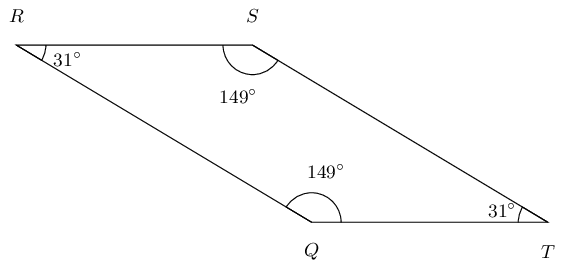
\[\begin{array}{|l |l|}
\hline
\text{Steps} & \text{Reasons} \\
\hline
R\hat{Q}T = R\hat{S}T & \text{given both } \angle \text{s} = 149^{\circ} \\
Q\hat{R}S = Q\hat{T}S & \text{given both } \angle \text{s} = 31^{\circ} \\
\hat{Q} + \hat{R} + \hat{S} + \hat{T} = 360 ^{\circ} & \text{sum of } \angle \text{s in quad} \\
R\hat{Q}T + Q\hat{T}S = 180 ^{\circ} & 149^{\circ} + 31^{\circ} = 180^{\circ} \\
\therefore QR \parallel TS & \text{co-int } \angle \text{s; } QR \parallel TS \\
\therefore RS \parallel QT & \text{co-int } \angle \text{s; } RS \parallel QT \\
\therefore QRST \text{ is a parallelogram} & \text{opp. sides parallel} \\
\hline
\end{array}\]
In parallelogram \(QTRS\), the bisectors of the angles have been constructed, indicated with the red lines
below. You are also given \(QT = SR\), \(TR = QS\), \(QT \parallel SR\), \(TR \parallel QS\), \(\hat{Q} =
\hat{R}\) and \(\hat{T} = \hat{S}\).
Prove that the quadrilateral \(JKLM\) is a parallelogram.
Note the diagram is drawn to scale.
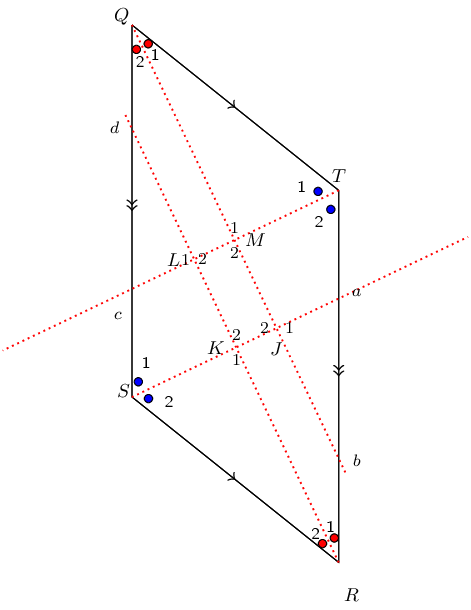
Redraw the diagram and mark all the known information:
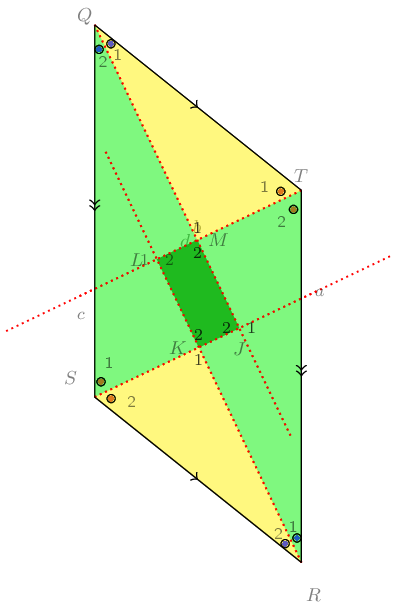
Study the diagram below; it is not necessarily drawn to scale. Two triangles in the figure are congruent:
\(\triangle CDE \equiv \triangle CBF\). Additionally, \(EA = ED\). You need to prove that \(ABFE\) is a
parallelogram.
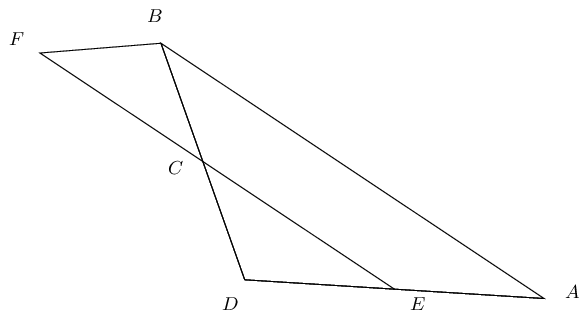
Redraw the diagram and mark all known and given information:
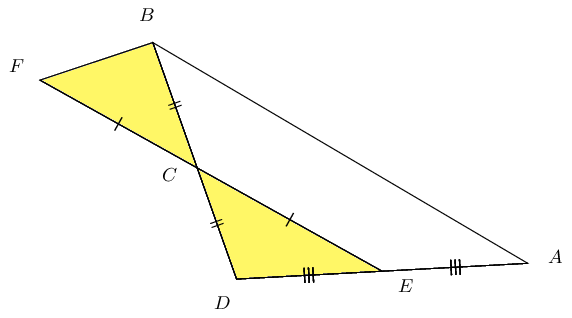
\(ABCD\) is a parallelogram. \(BEFC\) is a parallelogram. \(ADEF\) is a straight line. Prove that \(AE =
DF\).
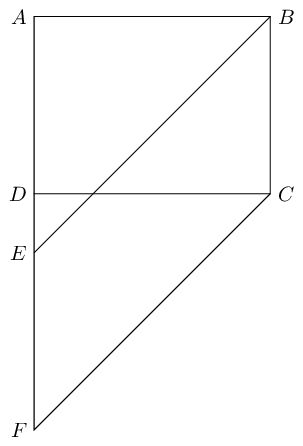
\begin{align*}
BC & = EF \text{ (opp sides of } \parallel \text{m)} \\
BC & = AD \text{ (opp sides of } \parallel \text{m)} \\
\therefore EF & = ED \\
AD + DE & = AE \\
EF + DE & = DF \\
\text{ but } DE & \text{ is common} \\
\therefore AE & = DF
\end{align*}
In the figure below \(AB = BF\), \(AD = DE\). \(ABCD\) is a parallelogram. Prove \(EF\) is a straight line.
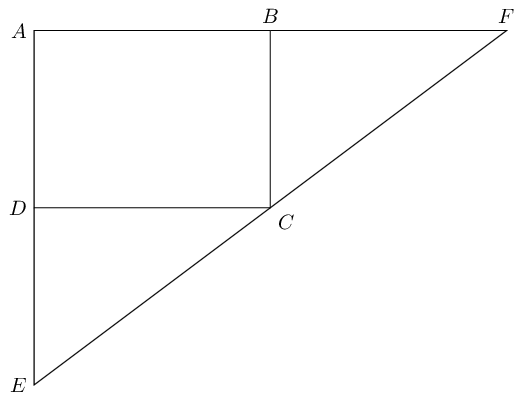
We note that:
\begin{align*}
B\hat{A}D & = B\hat{C}D \text{ (opp } \angle\text{s } \parallel \text{m)} \\
C\hat{D}E & = B\hat{C}D \text{ (alt } \angle\text{s; } AE \parallel BC \text{)} \\
F\hat{B}C & = B\hat{C}D \text{ (alt } \angle\text{s; } AF \parallel DC \text{)} \\
\therefore C\hat{D}E & = F\hat{B}C
\end{align*}
We also note that:
\begin{align*}
AD & = BC \text{ (opp sides parm eq)} \\
AB & = DC \text{ (opp sides parm eq)}
\end{align*}
Now we can show that \(\triangle DEC\) is congruent to \(\triangle BCF\):
\begin{align*}
\text{in } \triangle DEC & \text{ and } \triangle BCF\\
C\hat{D}E & = F\hat{B}C \qquad \text{(proven above)} \\
DC = AB & = BF \qquad \text{(given)} \\
DE = AD & = BC \qquad \text{(given)} \\
\therefore \triangle DEC & \equiv \triangle BCF \text{ (SAS)}
\end{align*}
Finally we can show that \(ECF\) is a straight line:
\begin{align*}
\therefore B\hat{F}C & = D\hat{C}E \text{ (}\triangle DEC \equiv \triangle BCF \text{)} \\
B\hat{C}F & = D\hat{E}C \text{ (}\triangle DEC \equiv \triangle BCF \text{)} \\
\text{but } F\hat{B}C + B\hat{F}C + B\hat{C}F & = 180° \text{(sum of }\angle\text{s in } \triangle
\text{)} \\
\therefore D\hat{C}E + B\hat{C}F + B\hat{C}D & = 180° \\
\therefore ECF & \text{ is a str line}
\end{align*}


